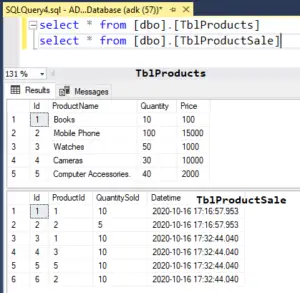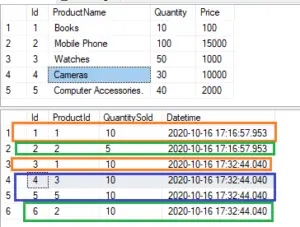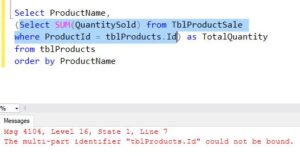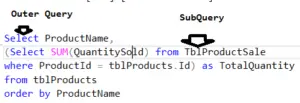Hello and welcome to Quickpickdeal Technologies. In this post, we will delve into Correlated Subqueries in SQL Server.
In our previous post on subqueries, we covered the fundamentals of subqueries. Additionally, we explored how subqueries can be replaced using joins. If you haven't read that post yet, I highly recommend doing so before proceeding with this one.
Correlated subqueries are straightforward and easy to comprehend. A subquery is considered correlated if it relies on values from the outer query for its execution.
Non-Correlated subquery
We will utilize the same tables as in the previous post of this series: TblProducts and TblProductSale.
The TblProducts table stores product information, while the TblProductSale table contains sales-related data. Each time a product is sold, an entry is recorded in the TblProductSale table.

Table Script
USE [TestDatabase] GO /****** Object: Table [dbo].[TblProducts] Script Date: 10/22/2020 12:38:00 PM ******/ SET ANSI_NULLS ON GO SET QUOTED_IDENTIFIER ON GO CREATE TABLE [dbo].[TblProducts]( [Id] [int] NOT NULL, [ProductName] [nvarchar](100) NOT NULL, [Quantity] [int] NOT NULL, [Price] [float] NULL, CONSTRAINT [PK_TblProducts] PRIMARY KEY CLUSTERED ( [Id] ASC ) ) ON [PRIMARY] GO /****** Object: Table [dbo].[TblProductSale] Script Date: 10/22/2020 12:38:00 PM ******/ SET ANSI_NULLS ON GO SET QUOTED_IDENTIFIER ON GO CREATE TABLE [dbo].[TblProductSale]( [Id] [int] NOT NULL, [ProductId] [int] NULL, [QuantitySold] [int] NULL, [Datetime] [datetime] NULL, CONSTRAINT [PK_TblProductSale] PRIMARY KEY CLUSTERED ( [Id] ASC ) ) ON [PRIMARY] GO INSERT [dbo].[TblProducts] ([Id], [ProductName], [Quantity], [Price]) VALUES (1, N'Books', 10, 100) GO INSERT [dbo].[TblProducts] ([Id], [ProductName], [Quantity], [Price]) VALUES (2, N'Mobile Phone', 100, 15000) GO INSERT [dbo].[TblProducts] ([Id], [ProductName], [Quantity], [Price]) VALUES (3, N'Watches', 50, 1000) GO INSERT [dbo].[TblProducts] ([Id], [ProductName], [Quantity], [Price]) VALUES (4, N'Cameras ', 30, 10000) GO INSERT [dbo].[TblProducts] ([Id], [ProductName], [Quantity], [Price]) VALUES (5, N'Computer Accessories.', 40, 2000) GO INSERT [dbo].[TblProductSale] ([Id], [ProductId], [QuantitySold], [Datetime]) VALUES (1, 1, 10, CAST(N'2020-10-16T17:16:57.953' AS DateTime)) GO INSERT [dbo].[TblProductSale] ([Id], [ProductId], [QuantitySold], [Datetime]) VALUES (2, 2, 5, CAST(N'2020-10-16T17:16:57.953' AS DateTime)) GO INSERT [dbo].[TblProductSale] ([Id], [ProductId], [QuantitySold], [Datetime]) VALUES (3, 1, 10, CAST(N'2020-10-16T17:32:44.040' AS DateTime)) GO INSERT [dbo].[TblProductSale] ([Id], [ProductId], [QuantitySold], [Datetime]) VALUES (4, 3, 10, CAST(N'2020-10-16T17:32:44.040' AS DateTime)) GO INSERT [dbo].[TblProductSale] ([Id], [ProductId], [QuantitySold], [Datetime]) VALUES (5, 5, 10, CAST(N'2020-10-16T17:32:44.040' AS DateTime)) GO INSERT [dbo].[TblProductSale] ([Id], [ProductId], [QuantitySold], [Datetime]) VALUES (6, 2, 10, CAST(N'2020-10-16T17:32:44.040' AS DateTime)) GO
Now, suppose I want to fetch all the products that have not been sold at least once. How would I construct such a query? Clearly, whenever a sale is made, entries are added to the TblProductSale table. Upon examining the sample data, it's evident that Cameras haven't been sold at least once.

Select Id, ProductName, Quantity,Price from [dbo].[TblProducts] where Id not in (Select Distinct ProductId from [dbo].[TblProductSale])
Now, look at this. how does this query gets executed?
The subquery is executed first. In this query, the subquery can be executed independently.

This is an example of a non-correlated subquery. In a non-correlated subquery, the subquery is not reliant on the outer query for its values. The subquery can be executed independently. Once the subquery is executed, its results are then substituted within the parentheses for use by the outer query.
Now, let’s look another example of a non-correlated subquery using the same examples discussed in the previous session.
Suppose, for instance, I wish to determine all the products that have been sold along with their total quantity.
Select ProductName, (Select SUM(QuantitySold) from TblProductSale where ProductId = tblProducts.Id) as TotalQuantity from tblProducts order by ProductName
I want to calculate the total quantity sold for each product. Therefore, the productID will be retrieved from the TblProducts table.Now, every time a row is selected from the outer query, the subquery is executed.
However, it's important to note that I cannot execute the subquery independently of the outer query. Attempting to do so results in an error."

Msg 4104, Level 16, State 1, Line 7
The multi-part identifier “tblProducts.Id” could not be bound.
That constitutes a correlated subquery because the subquery relies on the outer query for the value of the column 'productId'.

In this case, the subquery depends on the outer query for its value, specifically for the 'productId'. Thus, the subquery is correlated with the outer query.
Correlated subqueries are executed for each row selected by the outer query in our SELECT statement. Unlike non-correlated subqueries, correlated subqueries cannot be executed independently of the outer query.
Read Similar Articles
- Why we use Stored Procedure instead of Query?
- Instead Of Delete Trigger In Sql Server With Example
- What are the Advantages and Disadvantages of Indexes In Sql Server?
- How to create a Multi-Statement Table valued function
- Clustered and Non Clustered Index In Sql server With Real Example
- What is Sql Joins? With Realtime Examples